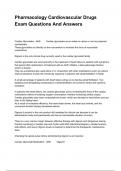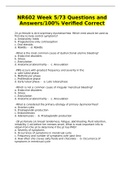Pharmacology Cardiovascular Drugs
Exam Questions And Answers
Cardiac Glycosides - ANS Cardiac glycosides occur widely in nature or can be prepared
synthetically.
These glycosides act directly on the myocardium to increase the force of myocardial
contractions.
Digoxin is the only clinical drug currently used in the cardiac glycoside family.
Cardiac glycosides are used primarily in the treatment of heart failure in patients with symptoms
that persist after optimization of treatment with an ACE inhibitor, a beta-adrenergic blocker,
and/or a diuretic.
They are sometimes also used alone or in conjunction with other medications (such as calcium
channel blockers) to slow the ventricular response in patients with atrial fibrillation or flutter.
A small percentage of patients with heart failure will go on to develop atrial fibrillation. Two
disabling and devastating complications of atrial fibrillation are ischemic stroke and systemic
embolism.
In patients with heart failure, the cardiac glycosides act by increasing the force of the cardiac
contractions without increasing oxygen consumption, thereby increasing cardiac output.
Cardiac glycosides also lower norepinephrine levels, which are elevated in heart failure and are
toxic to the failing heart.
As a result of increased efficiency, the heart beats slower, the heart size shrinks, and the
concurrent diuretic therapy decreases edema.
Digoxin (Lanoxin) is the only product still marketed for clinical use because it can be
administered orally and parenterally and has an intermediate duration of action.
There is a very narrow margin between effective therapy with digoxin and dangerous toxicity.
Careful monitoring of cardiac rate and rhythm with EKG (electrocardiogram), cardiac function,
side effects, and serum digoxin levels is required to determine the therapeutic maintenance
dose.
Checking the apical pulse before administering digoxin is an importan
Cardiac Glycoside Medication - ANS *digoxin*
,Cardiac Glycosides Toxic Side Effects - ANS Toxic side effects of digoxin, which should be
reported to the physician immediately, can include:
-Anorexia, nausea, and vomiting (early signs of toxicity)
-Abdominal cramping, distention, and diarrhea
-Headache, fatigue, lethargy, and muscle weakness
-Vertigo, restlessness, irritability, tremors, and seizures
-Visual disturbances including blurring, diplopia (double vision), or halos
-Cardiac arrhythmias of all kinds, especially bradycardia (rate less than 60)
-Electrolyte imbalance, especially potassium (either hyperkalemia or hypokalemia can cause
arrhythmias)
-Insomnia, confusion, and mental disorders, especially with older adults
Cardiac Glycosides Toxicity Treatment - ANS Treatment of digoxin toxicity includes:
-Discontinuing the drug immediately (usually sufficient)
-Monitoring electrolytes for hyperkalemia, hypokalemia, hypomagnesemia, and hypercalcemia
-Drugs such as atropine for symptomatic bradycardia
-Digoxin-specific Fab fragments (DigiFab) as an antidote in life-threatening toxicity
Cardiac Glycosides Precautions and Contraindications - ANS Precautions or
contraindications apply to:
-Severe pulmonary disease
-Hypothyroidism
-Acute myocardial infarction, acute myocarditis, and severe heart failure Impaired renal function;
hypokalemia and hypomagnesemia
-Arrhythmias not caused by heart failure
-Pregnancy and lactation
-High doses in older adults
Cardiac Glycosides Interactions - ANS Interactions of digoxin may occur with:
-Antacids, cholestyramine, neomycin, and rifampin (reduce the absorption of digoxin; administer
far apart)
-Diuretics, calcium, and corticosteroids (can increase the chance of arrhythmias)
-Macrolides and antiarrhythmics (especially quinidine and verapamil; may potentiate digoxin
toxicity)
-Adrenergics (epinephrine, ephedrine, and isoproterenol; increase the risk of arrhythmias)
Cardiac Glycosides Patient Education - ANS Patients taking digoxin should be instructed
regarding:
-Recognition and immediate reporting of side effects
,-Holding medication, if any side effects occur, until the physician can be consulted
-Avoiding taking any other medication at the same time without physician approval
-Avoiding all over-the-counter (OTC) medication, especially antacids and cold remedies
-Avoiding abrupt withdrawal after prolonged use; must be reduced gradually under physician
supervision
-Checking heart rate (pulse) on a regular basis
Antiarrhythmic Agents - ANS Antiarrhythmic agents include a variety of drugs that act in
different ways to suppress various types of cardiac arrhythmias, including atrial or ventricular
tachycardias, atrial fibrillation or flutter, and arrhythmias that occur with digoxin toxicity or during
surgery and anesthesia.
The choice of a particular antiarrhythmic agent is based on the careful assessment of many
factors, including the type of arrhythmia; frequency; cardiac, renal, or other pathological
condition; and current signs and symptoms.
The role of the health care practitioner is critical in this area in accurate and timely reporting of
vital signs, pertinent observations regarding the effectiveness of medications and adverse side
effects, and modification of precipitating causes.
Keep in mind that most of the drugs given to counteract arrhythmias have the potential for
lowering blood pressure and slowing heartbeat.
Therefore, it is especially important to be alert for the signs of hypotension and bradycardia,
which could lead to cardiac arrest.
Although the antiarrhythmics commonly slow the heart rate, there are exceptions (e.g.,
procainamide and quinidine, which may cause tachycardia).
When other cardiac drugs are administered concomitantly, cardiac effects may be additive or
antagonistic.
Antiarrhythmic agents can worsen existing arrhythmias or cause new arrhythmias, and therefore
careful monitoring is essential.
Arrhythmia detection or monitoring can include EKG rhythm strips and 24-h Holter monitoring as
indicated.
Electrolyte surveillance, especially for disorders of potassium and magnesium, is very important
for patients on antiarrhythmic agents.
Antiarrhythmic Medications - ANS *adenosine*
*amiodarone*
*lidocaine*
*procainamide*
*propafenone*
, beta-adrenergic blockers
calcium channel blockers
Antiarrhythmic - Adenosine - ANS Adenosine (Adenocard) is an injectable antiarrhythmic
agent with multiple electrophysiological activities that complicate its placement into a single
category.
It restores normal sinus rhythm in paroxysmal supraventricular tachycardia (PSVT) by slowing
conduction time through the atrioventricular (AV) node.
Adenosine also has vasodilatory, antiadrenergic, and negative chronotropic (decrease in rate)
properties, which act to decrease cardiac oxygen demand.
Adenosine is equal in effectiveness to diltiazem or verapamil in converting PSVT but is less
likely to cause hypotension.
Antiarrhythmic - Adenosine Side Effects - ANS Common side effects include:
-Facial flushing
-Lightheadedness, headache
-Dyspnea, and chest pressure
Antiarrhythmic - Adenosine Contraindications - ANS Adenosine is contraindicated in:
-Patients with a second-or-third-degree heart block or symptomatic bradycardia (unless a
functioning artificial pacemaker is present).
Antiarrhythmic - Amiodarone - ANS Amiodarone (Cordarone) is an oral and injectable
antiarrhythmic agent approved for the treatment of refractory life-threatening ventricular
arrhythmias.
Despite its problematic organ toxicity profile and black box warning, amiodarone is widely used
for preventing the recurrence of atrial fibrillation.
It is considered a broad-spectrum antiarrhythmic with multiple and complex electrophysiological
effects.
Amiodarone also relaxes both smooth and cardiac muscle, causing decreases in coronary and
peripheral vascular resistance and systolic blood pressure.
Amiodarone Side Effects - ANS Side effects of amiodarone, some of which are severe and
potentially fatal, but may be less of a problem with lower doses (i.e., 200-400 mg per day),
include:





